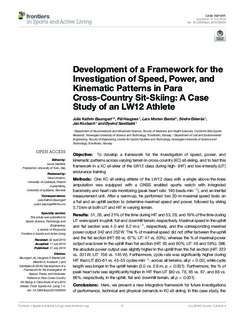| dc.description.abstract | Objective: To develop a framework for the investigation of speed, power, and kinematic patterns across varying terrain in cross-country (XC) sit-skiing, and to test this framework in a XC sit-skier of the LW12 class during high- (HIT) and low-intensity (LIT) endurance training.
Methods: One XC sit-skiing athlete of the LW12 class with a single above-the-knee amputation was equipped with a GNSS enabled sports watch with integrated barometry and heart rate monitoring (peak heart rate: 195 beats·min−1), and an inertial measurement unit. After a warm-up, he performed two 20-m maximal speed tests on a flat and an uphill section to determine maximal speed and power, followed by skiing 5.75 km at both LIT and HIT in varying terrain.
Results: 51, 28, and 21% of the time during HIT and 53, 28, and 19% of the time during LIT were spent in uphill, flat and downhill terrain, respectively. Maximal speed in the uphill and flat section was 4.0 and 6.2 m·s−1, respectively, and the corresponding maximal power output 342 and 252 W. The % of maximal speed did not differ between the uphill and the flat section (HIT: 66 vs. 67%, LIT: 47 vs. 50%), whereas the % of maximal power output was lower in the uphill than flat section (HIT: 65 and 80%, LIT: 46 and 58%). Still, the absolute power output was slightly higher in the uphill than the flat section (HIT: 222 vs. 201 W, LIT: 156 vs. 145 W). Furthermore, cycle rate was significantly higher during HIT than LIT (60–61 vs. 45–55 cycles·min−1, across all terrains, all p < 0.03), while cycle length was longer in the uphill terrain (3.0 vs. 2.6 m, p < 0.001). Furthermore, the % of peak heart rate was significantly higher in HIT than LIT (90 vs. 78, 85 vs. 67, and 88 vs. 66%, respectively, in the uphill, flat and downhill terrain, all p < 0.001).
Conclusions: Here, we present a new integrative framework for future investigations of performance, technical and physical demands in XC sit-skiing. In this case study, the increase in speed from LIT to HIT was due to increases in cycle rate in all terrains, while cycle length was less affected. Although the absolute power output was slightly higher in the uphill compared to the flat section both for HIT and LIT, the athlete worked closer to his maximum power output in the flat section. | nb_NO |
| dc.description.localcode | Copyright © 2019 Baumgart, Haugnes, Bardal, Østerås, Kocbach and Sandbakk. This is an open-access article distributed under the terms of the Creative Commons Attribution License (CC BY). The use, distribution or reproduction in other forums is permitted, provided the original author(s) and the copyright owner(s) are credited and that the original publication in this journal is cited, in accordance with accepted academic practice. No use, distribution or reproduction is permitted which does not comply with these terms. | nb_NO |

